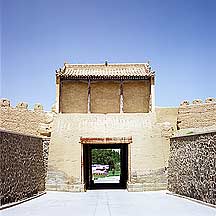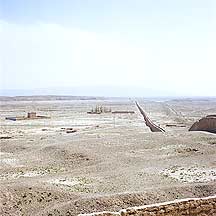Category: 万里长城Great Wall
-

The giant gate door is made up of a metal skin wrapped around a plank of solid wood.
-

You can go back in time and feel like a soldier by paying a yuan an arrow and shoot at the damn straw men below.
-

Unbelievably, someone decided to dig a pond in this desert area. One will have to bring the geese here, because I don't believe any animal will be willing to come here on their own.
-

The pond is of course on the east side of the Pass.
-

Today, the Pass is a tourist complex that includes the the Pass itself, a pond, a museum, a parking lot, ticket hall, and a memorial statue of Lin Zexu. This is one of several entrance structures.
-

This should be the east tower. Inside the fortress is a central lane that link the three towets.
-

The central lane is embedded with pebbles.
-

The arch tunnel of the middle tower.
-

-

-

One of the side entrance of the inner wall.
-

The design of the Pass is sophisticated. It is modular in concept, almost symmetrical in shape, maze-like in layout,and uniform in apperance. It has corner towers, enemy towers, arrow towers that protrude out the wall to defend from three sides, and trap spaces to lure enemies.
-

North and south walls both has one of these small tower. Their use is probably for storage and as temporary relief shelters.
-

The arch tunnel of the west gate.
-

-

-

The temple complex.
-

The entrance gate to the 关帝庙 Guandi temple. 关羽 Guanyu was a well-known general of the Three Kingdowms Era (222A.D. - 280A.D.). After his death, many temples were built to honor him and he was worshipped as 关帝 Guandi. His functions are many: generally, he is revered as a noble guardian of the poor (or wealthy), as one who wards off unwanted matters, as one to call for excellence in learning, as one to call for protection, and some others. You will find him everywhere -- in restaurants, in triads' terrotories, in police departments, in funeral homes, as well as many parts of the Great Wall.
-

There is a 关帝庙 Guandi Temple within the fortress. Much of the architectures and imagery has associations with Daoism.
-

Looking south.



